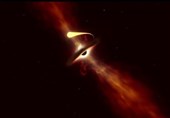Milky Way Black Hole Seemingly Changed Color of Nearby Stars
TEHRAN (Tasnim) – The supermassive black hole known as Sagittarius A* in the Milky Way galaxy seemingly changed the color of nearby stars, according to astrophysicists.
Sagittarius A* is the Milky Way's central black hole and an immeasurable amount of stars reside within 1.6 light-years of it, but it has less red giants stars than expected and according to a new report from Science News, astrophysicists theorize that Sagittarius A* is the culprit.
According to the theory, the black hole launched a powerful jet of gas that ripped off the outer layers of the galaxy's red giants, which saw the red part of the star removed as the star grew hotter and bluer as a result. That's the belief of Polish Academy of Sciences in Warsaw astrophysicist, Michal Zajaček, who published this theory on Nov. 12 in the Astrophysical Journal.
There aren't any powerful jets of gas coming from Sagittarius these days, but above and below the center of the Milky Way sits two large bubbles of gamma-ray emitting gas, which is possible evidence of the powerful jet that caused red giants near it to lose their outer layer 4 million years ago.
"The jet preferentially acts on large red giants," Zajaček said. "They can be effectively ablated by the jet."
Zajaček says red giant stars are more vulnerable than others to jets like this because of how large they are. These types of stars form when the center of smaller stars get so full of helium that it can no longer burn its hydrogen fuel and instead burns the hydrogen in a layer surrounding the center. This causes the star's outer layer to expand, which in turns causes the surface to cool and turn red. The resulting size makes red giants a prime target for jets like that of Sagittarius A*.
As these red giants orbit Sagittarius A*, they must pass through the jet Zajaček describes hundreds or thousands of times before the outer layer is ripped away and the red becomes blue. His team calculates that the jet is most effective at ripping off the outer layer of red giants within .13 light-years of the black hole.
University of California, Los Angeles astronomer, Tuan Do, says, however, that he believes it "may take a combination of several of these kinds of mechanisms to fully explain the lack of the red giants," according to Science News. He says it's likely something other than a jet that has caused the lack of red giants further away from the black hole.
Both Do and Zajaček theorize that it might be the work of a large disk of gas that circled the black hole millions of years ago. As the red giants orbited the black hole, they likely found themselves going through said disk and the disk's gas may have torn off their outer layers in the process.






